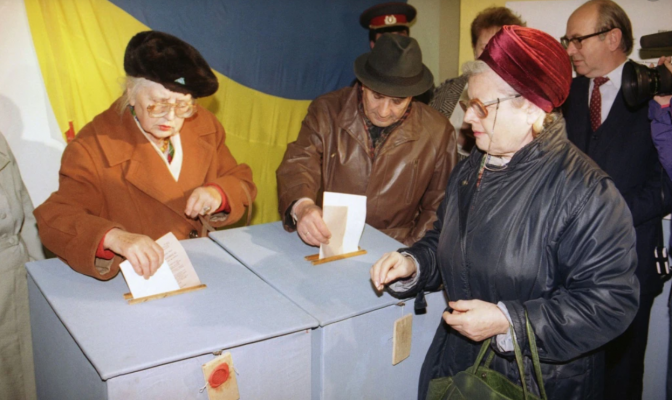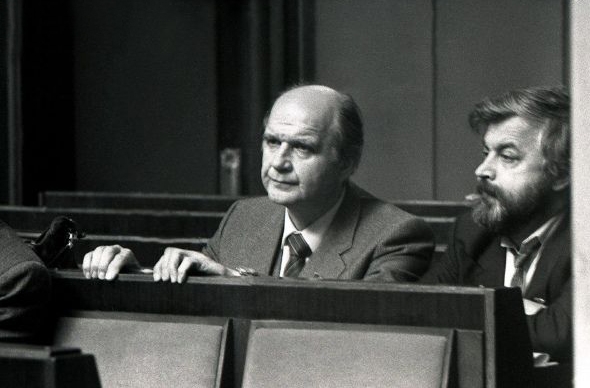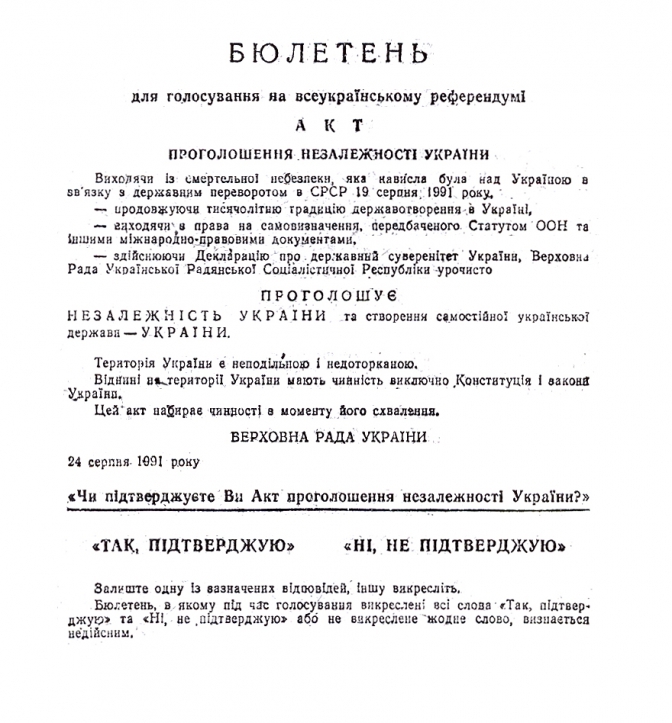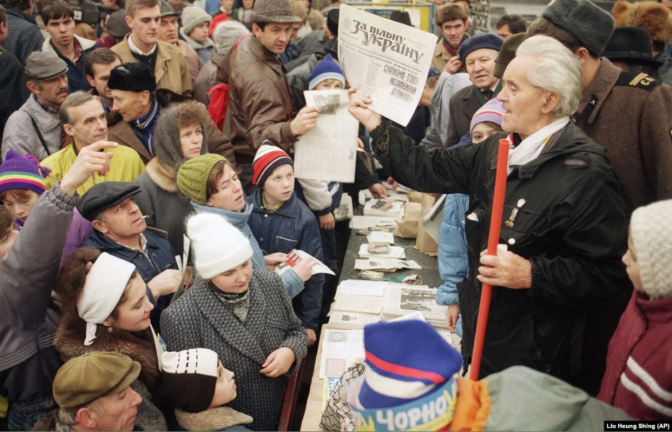
Photo: Ukrinform

Chairman of the People’s Council Igor Yukhnovsky in the session hall next to Les Tanyuk, a Ukrainian theatre and film director, dissident, and later a deputy of the parliament. Photo: zbruc.eu
After the deputies voted for the Act of Independence, Ihor Yukhnovskyi, a physicist who in 1990 became the leader of the first-ever opposition party in Soviet Ukraine, proposed to put this document to an all-Ukrainian referendum. At that time, for many deputies, including those from the anti-communist People’s Council (Narodna Rada), such a proposal did not seem entirely appropriate, as all the necessary decisions were made by the Verkhovna Rada (the Supreme Council, the Ukrainian Parliament).
One question was put to the referendum: «Do you confirm the Act of Independence of Ukraine?» And the 84.18 percent of the country’s population that voted responded resoundingly: 90.32% answered «Yes, I confirm.» In the Lviv, more than 97 percent agreed.
«I was absolutely convinced that we should declare Independence, but still, something was bothering me,» the now 95-year-old Ihor Yukhnovsky told Tvoe Misto/Lviv Now in August. «I had to speak at that meeting. Mostly, I wrote speeches quickly, but not this time. I didn’t know what to say. I walked around the room of the hotel «Ukraina» and realized that the proclamation of Ukrainian Independence was not a panacea. After all, there was the Verkhovna Rada of the Soviet Union, which could repeal this resolution.
«Therefore, I decided that the only way out was a referendum to approve the resolution on independence. This was the only thing that could make Ukraine stable,» – Ihor Yukhnovsky said.
 Ballot for voting on the all-Ukrainian referendum. The question: «Do you support the Act of Proclamation of Ukrainian independence?». Answers: «Yes, I approve» and «No, I don’t approve»
Ballot for voting on the all-Ukrainian referendum. The question: «Do you support the Act of Proclamation of Ukrainian independence?». Answers: «Yes, I approve» and «No, I don’t approve»

Kyiv, November 30, 1991. During the agitation in the center of the Ukrainian capital on the eve of the All-Ukrainian referendum for the independence of Ukraine
Only after the popular vote on 1 December did other countries begin recognizing Ukraine. On 2 December, Canada and Poland; 3 December, Hungary; 4 December, when the Central election committee summed up the plebiscite, Latvia and Lithuania. The day after: the Russian Federation, Argentina, Bulgaria, and so on.
On 5 December, the Verkhovna Rada proclaimed in its «Message to the Parliaments and Peoples of All Countries»: «Ukraine considers the 1922 Treaty on the Establishment of the USSR to be invalid and ineffective regarding itself.». On 8 December, the leaders of Ukraine, Russia, and Belarus, the key republics that formed the USSR in 1922, signed an agreement stating that the Union «as a subject of international law and geopolitical reality would cease to exist.»
Characteristically, no Soviet republic, except the Baltic ones, held its own independence referendum after the Ukrainian referendum.
«Independence has become stronger than us,» said Ihor Yukhnovskyi, who was born in what is now Poland and led the theoretical physics department at Lviv University. «It is impossible to deprive Ukraine of independence. After the referendum, we were recognized by all the countries of the world – this is an important moment that made us a state. And no one will take it away from us» – he added.
Let us remind that the full version of the memoir of 95-year-old Igor Yukhnovsky, an honorary Lviv resident, tells about how the resolution on Ukraine’s independence was prepared, why the Communists agreed to a referendum, and why Lviv was necessary here, can be read in our story: «We only made the last jerk. Ihor Yukhnovskyi on proclaiming the independence.»
The lowest number of supporters of independence was in Sevastopol (57.07%) and the Crimean Autonomy (54.19%)–places that since 2014 have once again been controlled by Moscow. The rest of the regions, including the eastern ones, cast more than 80% of the vote in support of the historic Act. The largest support was in Ternopil (98, 67%), Ivano-Frankivsk (98, 42%), Lviv (97.46%), Cherkasy (96.03%), Rivne (95.96%) and Kyiv (95.52%) areas.
For reference
Independent Ukraine was established in 1991, on the territory, where several states existed earlier:
The Rus’ federation with the centre in Kyiv (9th-13th centuries), before the Mongols invaded and destroyed it in 1241; during that time the grand dukes of Moscow sought to control the territory in the east including Kyiv which came under the Moscovy Empire, later the Tsardom of Russia.
Grand Duchy of Lithuania and Polish Kingdom (13th-16th centuries); and the Kingdom of Galicia-Volhynia, of which Lviv was the capital, from 1272-1349;
the Polish-Lithuanian Commonwealth in the 16th-18th centuries, within which the Ukrainian Cossack state emerged after the uprising of Bohdan Khmelnytskyi in 1648; and
then, the Ukrainian territory became divided between the Russian, Austrian, and Austro-Hungarian empires by the end of the 18th century (the latter took Western Ukraine, where Lviv is; Lviv, then-called Lemburg, was the capital of the Kingdom of Galicia and Lodomeria, called Austrian Galicia or Austrian Poland, functioning as a crownland of the Vienna-based Hapsburg Monarchy.
Temporarily, Ukrainian statehood was established in 1917-1921 years, between the demise of the Russian empire and creation of the Soviet Union. From November 1918 to July 1919, the West Ukrainian People’s Republic existed in Eastern Galicia, including Lviv and the Ukrainian Carpathian mountains. Then in that region, Poland took control of the
Then in 1919, much of Ukraine in the form of a formally autonomous Ukrainian Soviet Socialist Republic was put again under the direct influence of Moscow for 70 years. Western Ukraine (Galicia) became part of Soviet Ukraine in 1939 after the German-Soviet invasion of Poland, with a 1941-44 Nazi occupation before returning to the USSR.
During the 30 years of Ukrainian independence, it endured three revolutions: Student revolution of Granite in 1989 (two years before the proclamation of Independence, where students started a hunger strike calling for democratisation, sovereignty of the Ukrainian SSR and undergoing military service exclusively on its territory), Orange revolution in 2004, when the citizens prevented the first effort of Viktor Yanukovych to become Ukrainian president after falsifying the votes, and the Revolution of Dignity in 2013-2014, when Yanukovych, then a 5th president of Ukraine, fled to Russia after ordering to shoot Ukrainian protesters on the Maidan, hence the nickname Euromaidan.
Translated by Vitalii Holich, with Joe Lindsley
You can read a Ukrainian language version of this story here.
Follow Lviv Now on Facebook and Instagram. To receive our weekly email digest of stories, please follow us on Substack.
Lviv Now is an English-language website for Lviv, Ukraine’s «tech-friendly cultural hub.» It is produced by Tvoe Misto («Your City») media-hub, which also hosts regular problem-solving public forums to benefit the city and its people.












